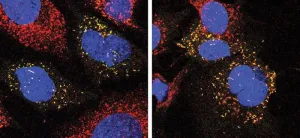(Press-News.org) International research led by the Translational Synthetic Biology Laboratory of the Department of Medicine and Life Sciences (MELIS) at Pompeu Fabra University has succeeded in efficiently engineering Cutibacterium acnes -a type of skin bacterium- to produce and secrete a therapeutic molecule suitable for treating acne symptoms. The engineered bacterium has been validated in skin cell lines and its delivery has been validated in mice. This finding opens the door to broadening the way for engineering non-tractable bacteria to address skin alterations and other diseases using living therapeutics.
The research team is completed by scientists from the Bellvitge Biomedical Research Institute (Idibell), the University of Barcelona, the Protein Technologies Facility of the Centre for Genomic Regulation, Phenocell SAS, Medizinische Hochschule Brandenburg Theodor Fontane, Lund University, and Aarhus University.
Acne is a common skin condition caused by the blockage or inflammation of the pilosebaceous follicles. Its appearance can vary, ranging from whiteheads and blackheads to pustules and nodules, mainly on the face, forehead, chest, upper back and shoulders. Although acne is most common among adolescents, it can affect people of all ages.
The most severe cases of acne are treated with antibiotics to kill bacteria living in the follicles, or isotretinoin (known as Accutane), a vitamin A derivative, which induces the death of sebocytes, the epithelial skin cells that produce sebum. However, these treatments can cause serious side effects such as breaking skin microbiome homeostasis -because they are not selectively killing bacteria- or photosensitivity, in the case of antibiotics, or birth defects or extreme scaling of skin, in the case of isotretinoin.
The results of the study, published today in Nature Biotechnology, show that researchers have successfully edited the genome of Cutibacterium acnes to secrete and produce NGAL protein known to be a mediator of the acne drug, isotretinoin, that has been shown to reduce sebum by inducing the death of sebocytes.
“We have developed a topical therapy with a targeted approach, using what nature already has. We engineered a bacterium that lives in the skin and make it produce what our skin needs. Here, we focused on treating acne, but this platform can be extended to several other indications”, says Nastassia Knödlseder, first author of the study.
Broadening the way of engineering bacteria
“Until now, C. acnes was considered an intractable bacterium. It was incredibly difficult to introduce DNA and get proteins produced or secreted from an element inserted into its genome”, explains Knödlseder, who is a postdoc in the UPF Translational Synthetic Biology Laboratory.
However, since C. acnes seems an attractive synthetic biology chassis for treating skin diseases due to its niche environment deep inside hair follicles -practically where sebum is released-, its importance for skin homeostasis, its close contact to relevant therapeutic targets, plus the fact that it has been shown to successfully engraft when applied to human skin, led them to insist on editing the genome of this non-engineerable bacterium.
To edit the genome of C. acnes, the research team led by Marc Güell has focused on improving DNA delivery to the cell, DNA stability inside the cell, and gene expression. The scientists have considered regulatory measures by developing a biocontainment strategy to avoid the use of elements that generate regulatory concerns such as mobile genetic elements, plasmids or antibiotic resistance. Hence, the resulting synthetic bacterium has safety features to enable “real-life application” and consider it for future human therapeutics.
Synthetic C. acnes is able to secrete and produce NGAL to modulate sebum production in cell lines. When applied to the skin of mice -the only animal model able to test engineered bacteria to date- they engraft, live and produce the protein. However, mice skin it is not comparable to humans’. It has more hair, is looser, has less lipids and a different sweat mechanism. Hence the need for an alternative model, better representing human skin, such as 3D skin models.
The road to therapeutics
“We have developed a technology platform that opens the door to editing any bacteria to treat multiple diseases. We are now focused in using C. acnes to treat acne but we can deliver genetic circuits to create smart microbes for applications related to skin sensing, or immune modulation”, points out Marc Güell, who has led the research.
Following the same strategy, this research line will continue under the European Project ‘SkinDev’ in which scientists from the Translational Synthetic Biology lab together with its partners will engineer C. acnes to address atopic dermatitis, a chronic cutaneous inflammatory condition characterized by dry skin, eczema and severe irritation, especially common among young children.
Although any living therapeutics strategy should be validated individually, the researchers show their optimism in applying these smart microbes to humans because non-engineered C. acnes has already been tested on the skin of patients safely and effectively.
END
Smart skin bacteria are able to secrete and produce molecules to treat acne
An experimental study led by the Translational Synthetic Biology Laboratory of Pompeu Fabra University has shown that a type of skin bacterium can efficiently be engineered to produce a protein to regulate sebum production. This application could treat ac
2024-01-09
ELSE PRESS RELEASES FROM THIS DATE:
Stranger than friction: A force initiating life
2024-01-09
As the potter works the spinning wheel, the friction between their hands and the soft clay helps them shape it into all kinds of forms and creations. In a fascinating parallel, sea squirt oocytes (immature egg cells) harness friction within various compartments in their interior to undergo developmental changes after conception. A study from the Heisenberg group at the Institute of Science and Technology Austria (ISTA), published in Nature Physics, now describes how this works.
The sea is full of fascinating life forms. From algae and colorful fish to marine snails and sea squirts, a completely different world reveals itself underwater. Sea squirts or ascidians in particular are very unusual: ...
Different biological variants discovered in Alzheimer's disease
2024-01-09
Dutch scientists have discovered five biological variants of Alzheimer's disease, which may require different treatment. As a result, previously tested drugs may incorrectly appear to be ineffective or only minimally effective. This is the conclusion of researcher Betty Tijms and colleagues from Alzheimer Center Amsterdam, Amsterdam UMC and Maastricht University. The research results will be published on 9 January in Nature Aging.
In those with Alzheimer's disease, the amyloid and tau protein clump in the brain. In addition to these clumps, other biological processes such as inflammation and nerve ...
Alzheimer Europe adopts position on anti-amyloid therapies for Alzheimer’s disease, issuing a call to action for timely, safe and equitable access
2024-01-09
Luxembourg, 9 January 2024 – In a new position paper, and following engagement with its national members and the European Working Group of People with Dementia (EWGPWD), Alzheimer Europe calls for concrete actions to enable timely, safe and equitable access to anti-amyloid drugs, for patients who are most likely to benefit from these innovative new treatments for Alzheimer’s disease (AD).
The growing prevalence and impact of AD has catalysed huge investments in research on its causes, diagnosis, treatment and care. After many high-profile ...
Improved cellular recycling could benefit patients with neurodegenerative conditions
2024-01-09
For the first time, a research team at The Hospital for Sick Children (SickKids) has uncovered a way to potentially reduce the amount of toxic cellular waste accumulating in patients with Zellweger Spectrum Disorder (ZSD).
ZSD is a group of rare, neurodegenerative genetic conditions caused by genetic variations that reduce the number of peroxisomes – the parts of cells that are responsible for, among other tasks, breaking down fats. ZSD varies in severity and is characterized by progressive neurodegeneration as well as symptoms that range from visual impairments, such as cataracts, to liver and kidney disfunction.
Like all living ...
Green ammonia could decarbonize 60% of global shipping when offered at just 10 regional fuel ports
2024-01-09
A study published today in IOP Publishing’s journal Environmental Research: Infrastructure and Sustainability has found that green ammonia could be used to fulfil the fuel demands of over 60% of global shipping by targeting just the top 10 regional fuel ports. Researchers at the University of Oxford looked at the production costs of ammonia which are similar to very low sulphur fuels, and concluded that the fuel could be a viable option to help decarbonise international shipping by 2050.
Around USD 2 trillion will be needed to transition to a green ammonia fuel supply chain by 2050, primarily to finance ...
Samsung leads again in U.S. patents while Qualcomm leaps into second place; overall grants dip 3.4%
2024-01-09
New Haven, Conn., Jan. 9, 2024—U.S. patent grants declined 3.4% from 2022, the lowest level since 2019, and Samsung held onto the top spot for the second year in a row according to IFI CLAIMS Patent Services, world leader in tracking patent application and grant data.
IFI CLAIMS Patent Services is a Digital Science company that compiles and tracks data from the U.S. Patent and Trademark Office (USPTO) and other patent-issuing agencies around the globe. IFI translates its world-leading data into an annual U.S. Top 50 and IFI Global 250 patent rankings, providing valuable insights into companies’ R&D activity.
Other findings in IFI’s latest rankings include patent powerhouse ...
Severe MS predicted using machine learning
2024-01-09
A combination of only 11 proteins can predict long-term disability outcomes in multiple sclerosis (MS) for different individuals. The identified proteins could be used to tailor treatments to the individual based on the expected severity of the disease. The study, led by researchers at Linköping University in Sweden, has been published in the journal Nature Communications.
“A combination of 11 proteins predicted both short and long-term disease activity and disability outcomes. We also concluded that it’s important to measure ...
Combining anti-tumor drugs with chemo may improve rare children’s cancer outcomes
2024-01-09
Children who develop neuroblastomas, a rare form of cancer which develops in nerve cells, may benefit from receiving certain anti-tumour drugs as well as chemotherapy, a new trial has found.
The results of the BEACON trial conducted by the Cancer Research UK Clinical Trials Unit at the University of Birmingham found that combining anti-angiogenic drugs, which block tumours from forming blood vessels, alongside various chemotherapy drugs led to more young people seeing their tumours shrinking, from 18% in the control group to 26% among those on Bevacizumab.
The findings are published in the Journal of Clinical Oncology today. The trial saw 160 young ...
EBRAINS research infrastructure secures €38 million in funding for new phase of digital neuroscience
2024-01-09
The European Commission has accepted the EBRAINS 2.0 proposal submitted in response to the INFRASERV call, granting €38 million for the further development of services of the EBRAINS research infrastructure.
The European Commission has signed a grant agreement to fund EBRAINS with €38 million until 2026. Over the next three years, the infrastructure will continue to develop tools and services to widely serve research communities in neurosciences, brain medicine, and brain-inspired technologies.
EBRAINS (European Brain Research Infrastructures) is an EU co-funded collaborative research platform designed to advance neuroscience and brain ...
Train your brain to overcome tinnitus
2024-01-09
An international research team has shown that the debilitating impact of tinnitus can be effectively reduced in just weeks by a training course and sound therapy delivered via a smartphone app.
The team from Australian, New Zealand, French and Belgian universities report these findings today in Frontiers in Audiology and Otology.
It offers some hope for millions affected by tinnitus who:
have been told that there is nothing they can do about it
face long queues waiting for treatment, or
can’t afford the costs of specialist support.
The initial trial worked with 30 sufferers, of whom almost two thirds experienced a ‘clinically ...
LAST 30 PRESS RELEASES:
Injectable breast ‘implant’ offers alternative to traditional surgeries
Neuroscientists devise formulas to measure multilingualism
New prostate cancer trial seeks to reduce toxicity without sacrificing efficacy
Geometry shapes life
A CRISPR screen reveals many previously unrecognized genes required for brain development and a new neurodevelopmental disorder
Hot flush treatment has anti-breast cancer activity, study finds
Securing AI systems against growing cybersecurity threats
Longest observation of an active solar region
Why nail-biting, procrastination and other self-sabotaging behaviors are rooted in survival instincts
Regional variations in mechanical properties of porcine leptomeninges
Artificial empathy in therapy and healthcare: advancements in interpersonal interaction technologies
Why some brains switch gears more efficiently than others
UVA’s Jundong Li wins ICDM’S 2025 Tao Li Award for data mining, machine learning
UVA’s low-power, high-performance computer power player Mircea Stan earns National Academy of Inventors fellowship
Not playing by the rules: USU researcher explores filamentous algae dynamics in rivers
Do our body clocks influence our risk of dementia?
Anthropologists offer new evidence of bipedalism in long-debated fossil discovery
Safer receipt paper from wood
Dosage-sensitive genes suggest no whole-genome duplications in ancestral angiosperm
First ancient human herpesvirus genomes document their deep history with humans
Why Some Bacteria Survive Antibiotics and How to Stop Them - New study reveals that bacteria can survive antibiotic treatment through two fundamentally different “shutdown modes”
UCLA study links scar healing to dangerous placenta condition
CHANGE-seq-BE finds off-target changes in the genome from base editors
The Journal of Nuclear Medicine Ahead-of-Print Tip Sheet: January 2, 2026
Delayed or absent first dose of measles, mumps, and rubella vaccination
Trends in US preterm birth rates by household income and race and ethnicity
Study identifies potential biomarker linked to progression and brain inflammation in multiple sclerosis
Many mothers in Norway do not show up for postnatal check-ups
Researchers want to find out why quick clay is so unstable
Superradiant spins show teamwork at the quantum scale
[Press-News.org] Smart skin bacteria are able to secrete and produce molecules to treat acneAn experimental study led by the Translational Synthetic Biology Laboratory of Pompeu Fabra University has shown that a type of skin bacterium can efficiently be engineered to produce a protein to regulate sebum production. This application could treat ac






